SN1/SN2/E1/E2 Decision
SN1 vs E1 and SN2 vs E2 : The Temperature
Last updated: November 21st, 2025 |
SN1 vs E1, and SN2 vs. E2: The Role Of Heat
- This article assumes you understand the mechanisms of the SN1/SN2/E1 and E2 reactions. For review, see here [SN1] [SN2] [E1] [E2]
- SN1/SN2/E1/E2 reactions tend to happen on alkyl halides [see Identifying Where Substitution and Elimination Reactions Happen]
- Determining whether the alkyl halide is primary, secondary, tertiary (or methyl) helps to narrow down the possibilities [See SN1/SN2/E1/E2 – The Substrate]
- When the nucleophile/base is negatively charged, the reaction tends to be SN2/E2. When the nucleophile/base is neutral, the reaction tends to be SN1/E1. [See SN1/SN2/E1/E2 – The Nucleophile/Base ]
- If the major reaction pathway cannot be determined by examining these factors, the next useful indicator is to look at the temperature.
- Generally, if you are trying to decide between SN1 and E1 (e.g. for a tertiary alkyl halide with a neutral nucleophile/base), heat (Δ ) indicates E1, whereas the absence of heat indicates SN1
- If you are trying to decide between SN2 and E2 (e.g. for a secondary alkyl halide with a strong base, e.g. HO(-) or RO(-) ) , heat (Δ ) indicates E2. (The absence of heat does not necessarily indicate SN2 – check with your instructor).
- Heat may also be indicated in difficult SN1 reactions (e.g. secondary alkyl halide, neutral nucleophile/base) where rearrangements occur.
I also suggest, ahem, pinning down your instructor beforehand on some of these questions because these questions can be subject to a lot of variation.
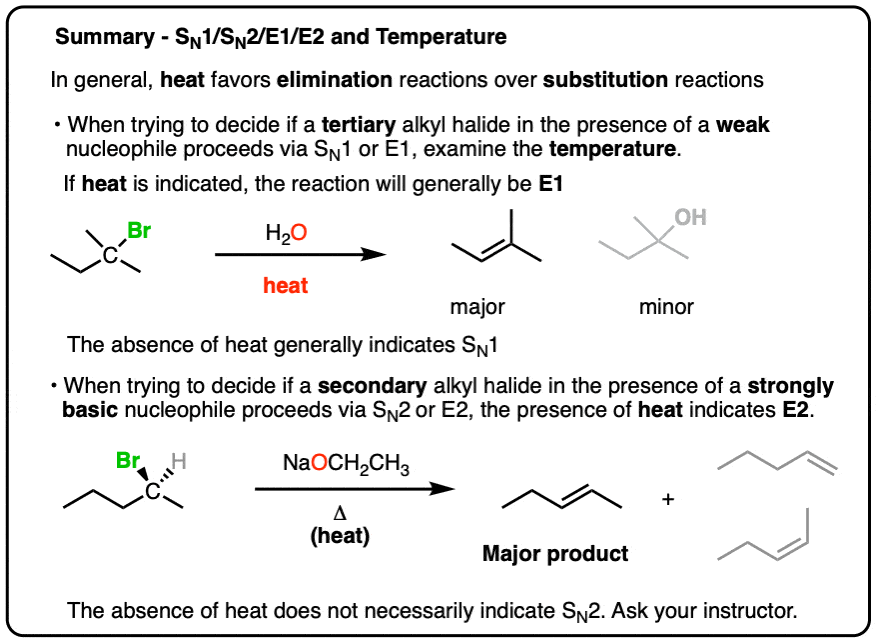
Table of Contents
1. The Role of “Heat” (Δ) In Substitution and Elimination Reactions
Previously we’ve outlined the main steps in deciding whether a reaction goes through SN1/SN2/E1/E2. (Note – it’s assumed by this point that if you know the mechanism of the reaction, you should be able to correctly draw the product!)
These steps are, roughly:
- Identify an sp3 hybridized (alkyl) carbon…
- with a good leaving group…
- classify the carbon as primary, secondary or tertiary…
- identify the strongest nucleophile/base in the reaction (for our purposes, I will often refer to negatively charged species as “strong” and neutral species as “weak“, although there are some exceptions – see article).
If you’ve gone through all these steps and applied the key rules, there are only a handful of possible dilemmas you might be facing based on what we’ve covered so far.
Those dilemmas are:
- A tertiary carbon with a weak nucleophile/base: SN1 vs E1
- A secondary carbon with strongly basic nucleophile like RO(-) or HO(-): E2 vs SN2
- A primary alkyl halide with a strong, bulky base like t-butoxide (t-BuO– ).
Once you’ve looked at those factors, the next factor to evaluate is the temperature.
- The key point of this article is that if heat is indicated, it’s almost certainly elimination, not substitution, because heat favors elimination reactions. [See post: Elimination Reactions Are Favored By Heat]
2. Evaluating SN1 vs E1 : The Role of Heat
Alright. Let’s dig into our first case.
Say we have a tertiary alkyl halide with a weak (neutral) base
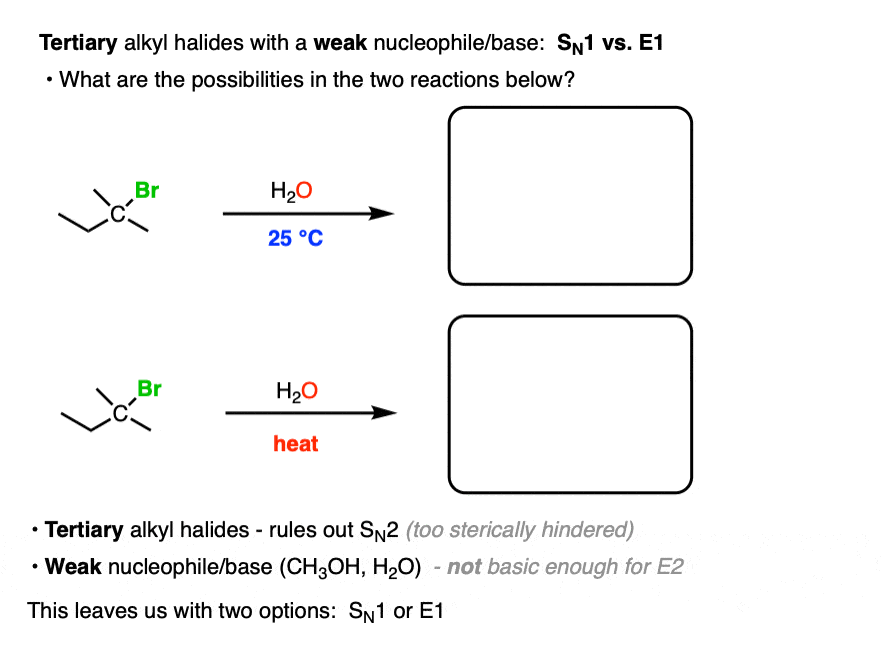
- You should already have ruled out SN2, due to steric hindrance [See article: The SN2 mechanism]
- We have a weak base, which generally rules out E2.
That leaves us with two solid possibilities. SN1 or E1.
In practice, these reactions generally give a mixture of substitution (SN1) and elimination (E1) products.
That being said:
- Lower temperatures (e.g. room temperature, 25 °C) tend to provide mostly SN1 products.
- Higher temperatures (“heat”) tend to provide mostly E1 products.
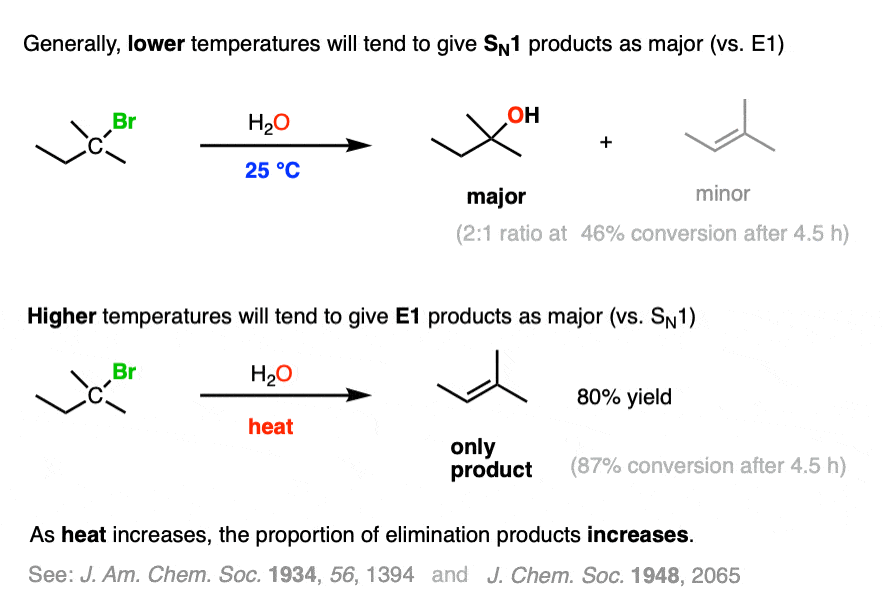
In the lab, there is lots of variation, but invariably, higher temperatures result in more elimination. For some real-life results, see Note 1. (See article: Elimination Reactions Are Favored By Heat)
Let’s look at some representative quizzes:
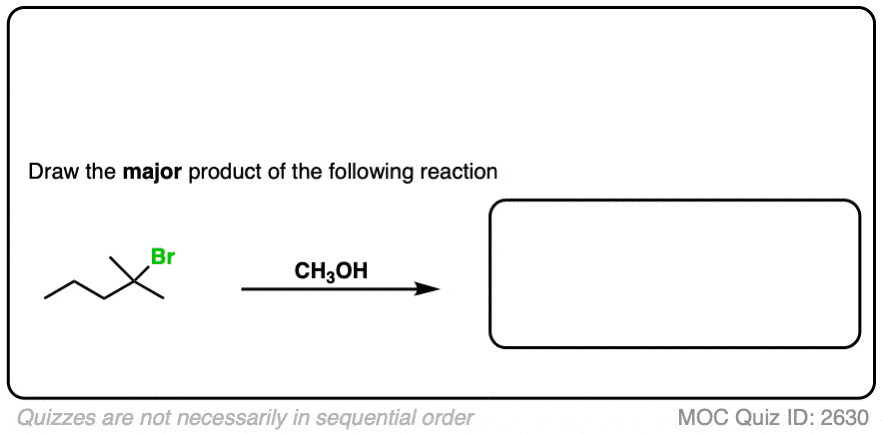 Click to Flip
Click to Flip
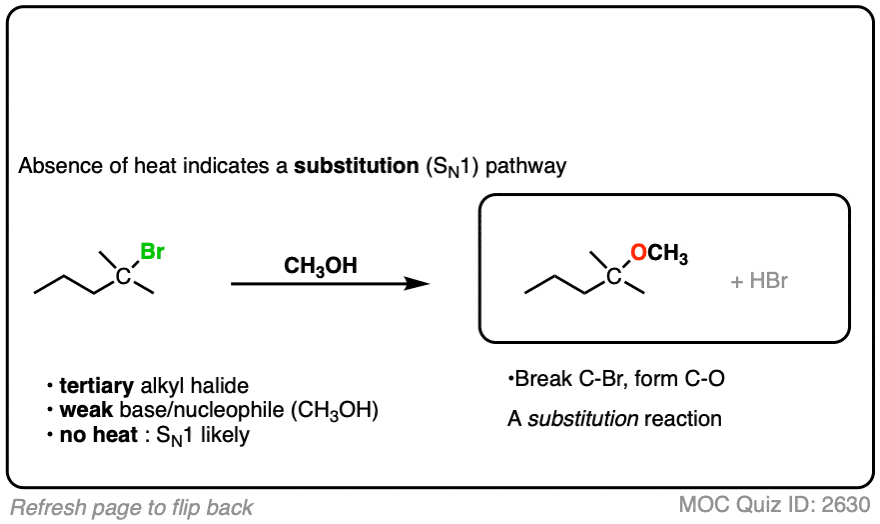
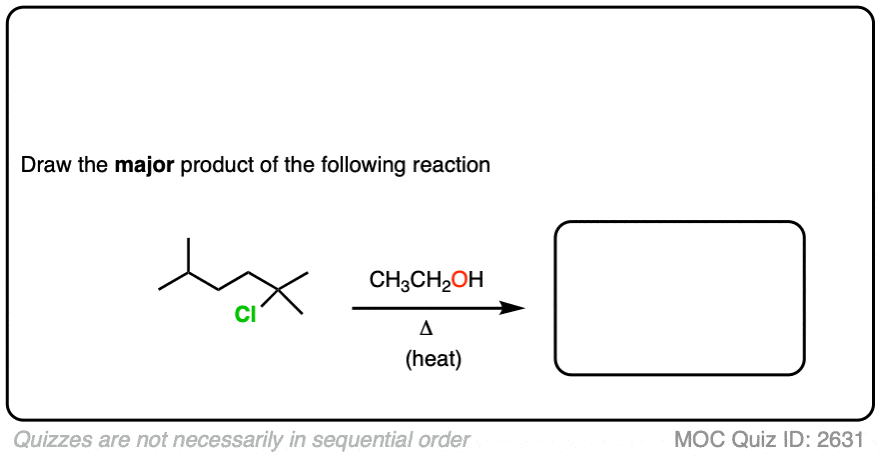 Click to Flip
Click to Flip
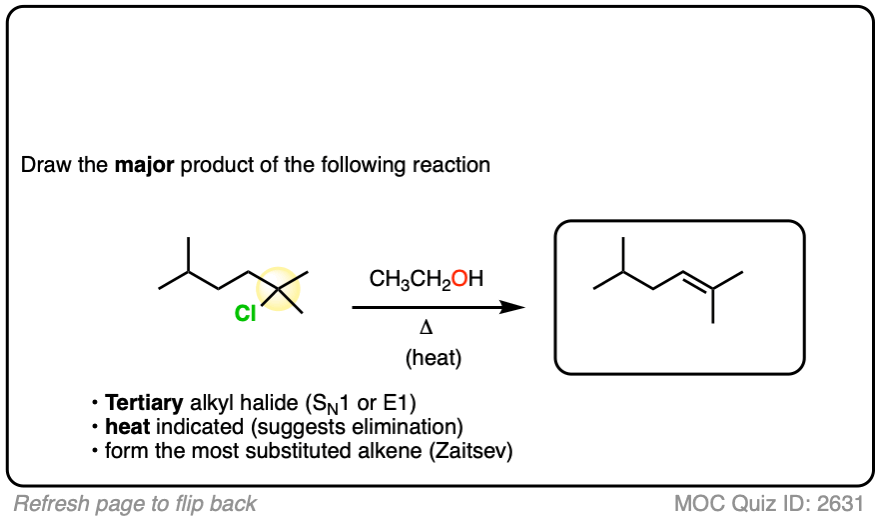
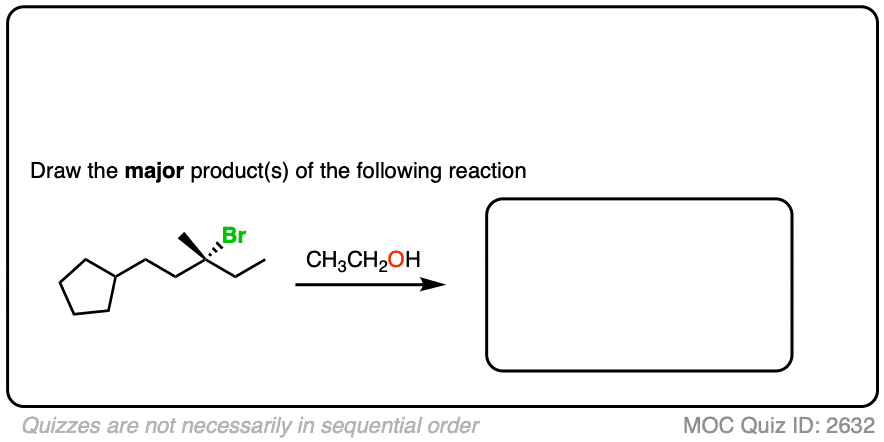 Click to Flip
Click to Flip

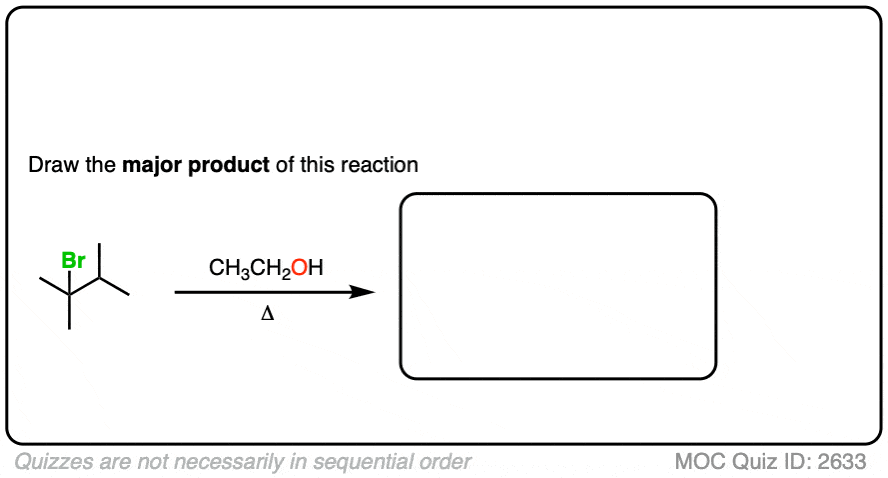 Click to Flip
Click to Flip
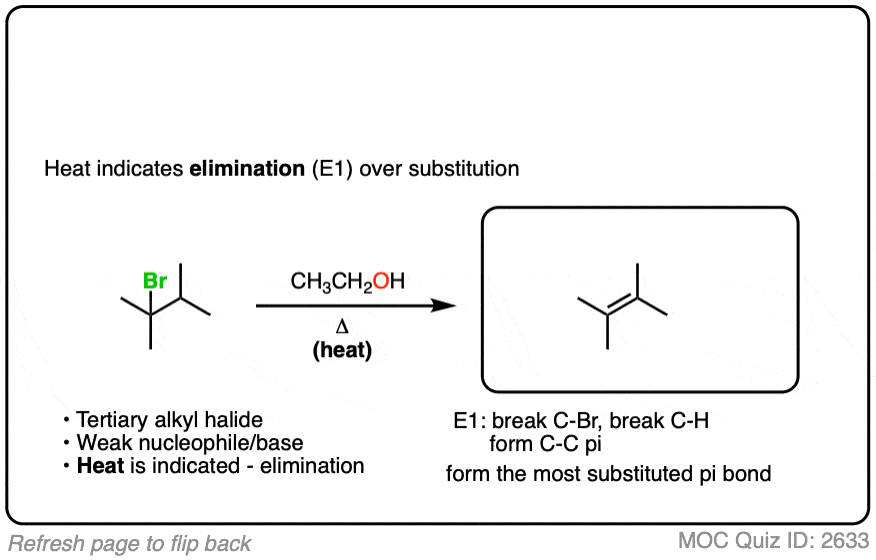
3. SN2 vs E2 – Secondary Alkyl Halides
Another dilemma faces us when we encounter a secondary alkyl halide with a strong base such as an alkoxide (e.g. sodium methoxide, NaOCH3 or potassium ethoxide, KOCH2CH3 ) or hydroxide (HO– ) ion.
- The charged nucleophile/base generally rules out E1 and SN1
- An alkoxide (conjugate base of an alcohol, pKa 16-18) is strong enough to perform elimination through the E2 pathway.
- However, a secondary carbon is not sterically hindered enough to completely rule out SN2
So our choices at this point are either E2 or SN2 :
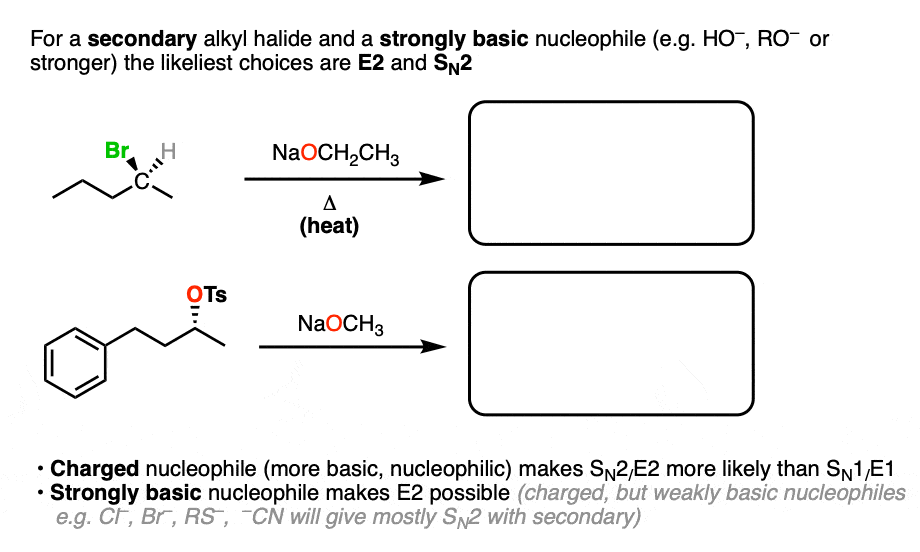
- If heat is applied, then the major product is almost certainly E2 since elimination reactions are favored by heat.
- Absence of heat it does not necessarily imply SN2. But it might. Ask your instructor, because answers vary.
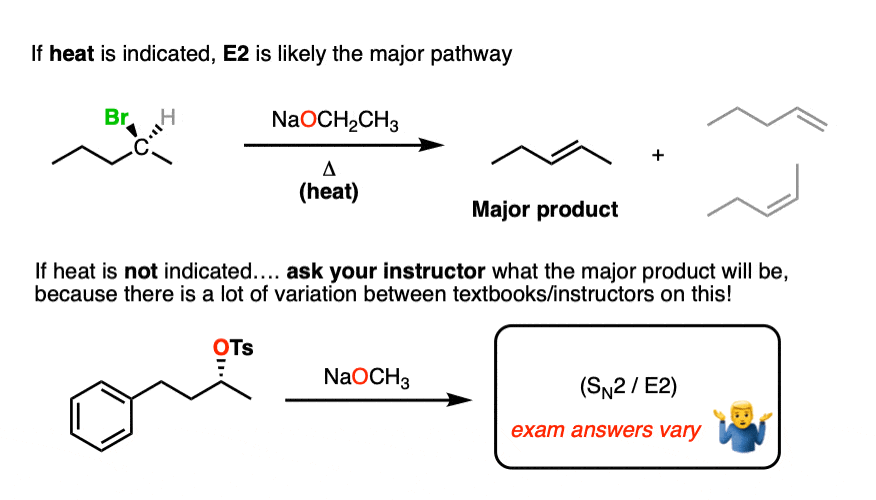
For some laboratory results with secondary alkyl halides and strongly basic nucleophiles, see [Note 2 ]
Here are some relevant quizzes:
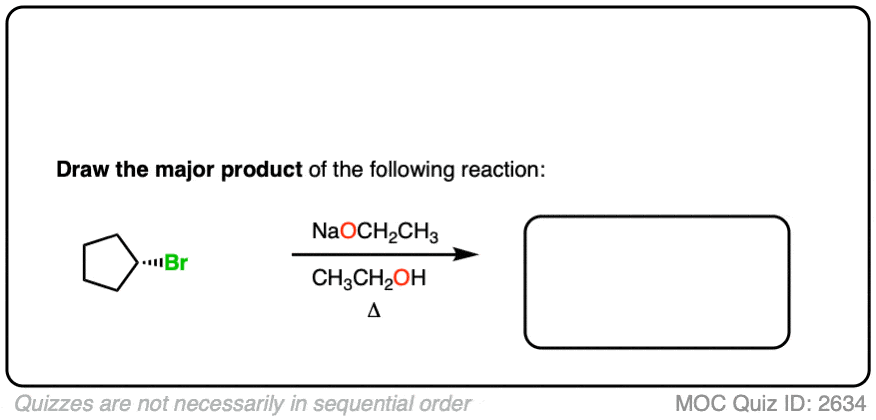 Click to Flip
Click to Flip
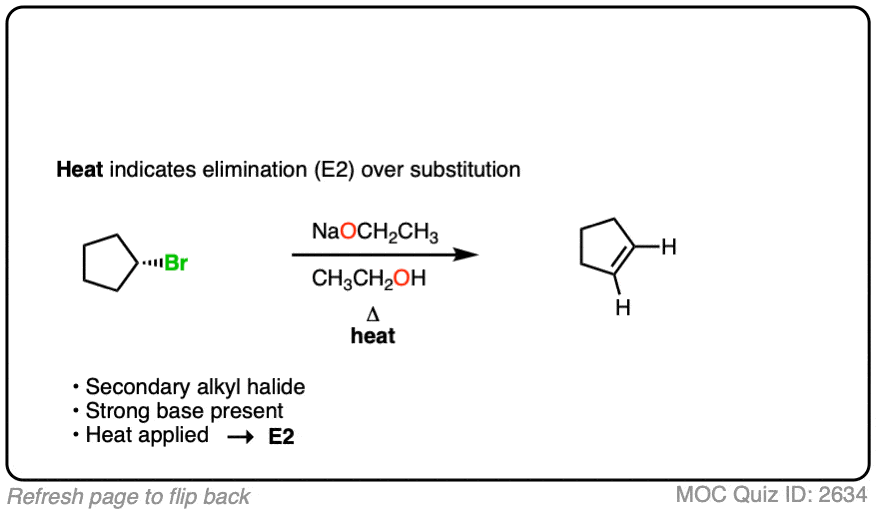
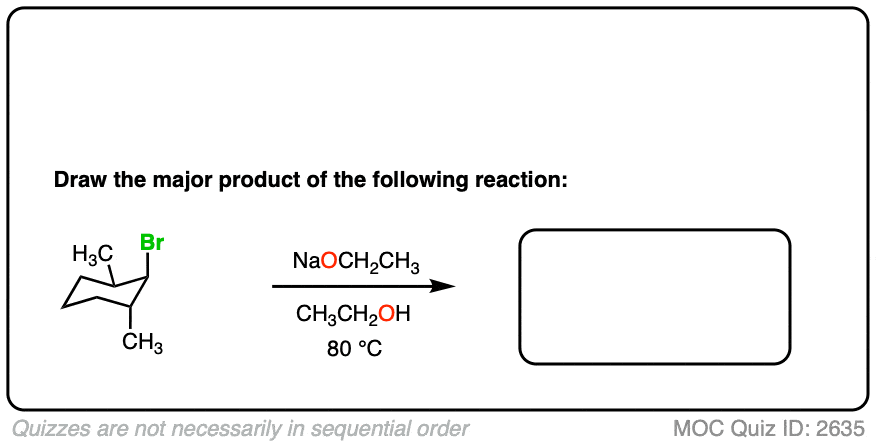 Click to Flip
Click to Flip
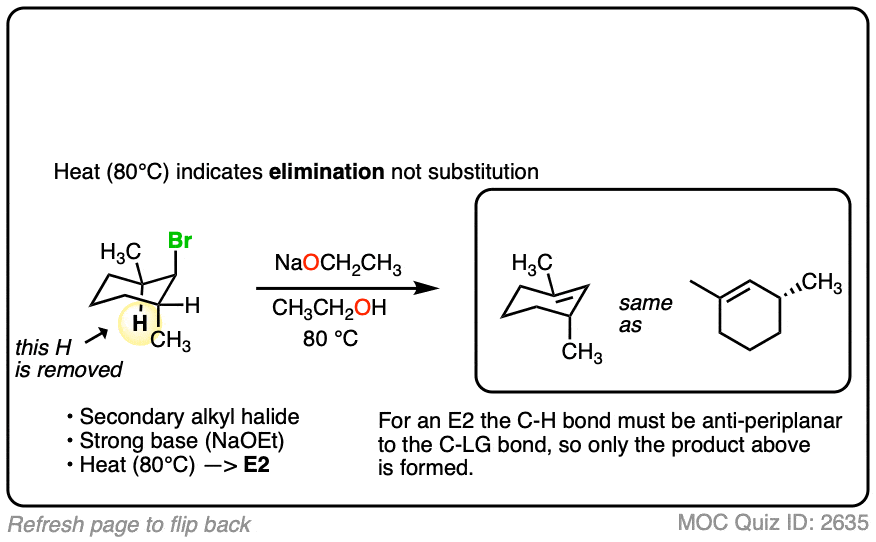
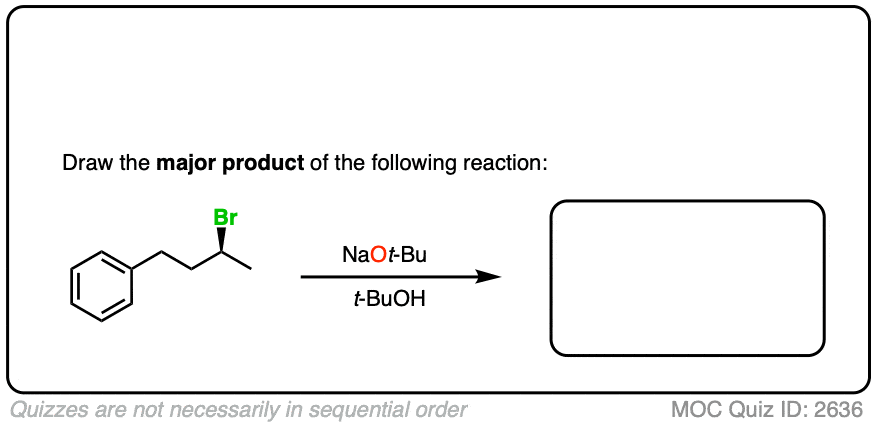 Click to Flip
Click to Flip
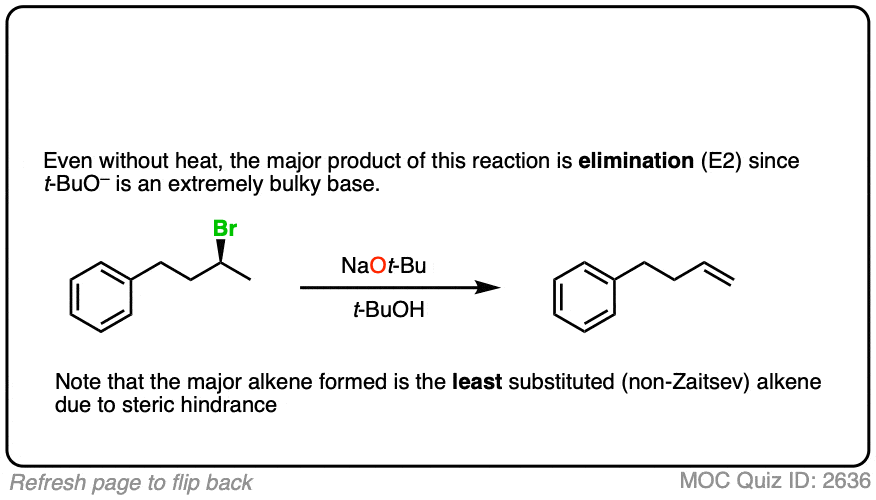
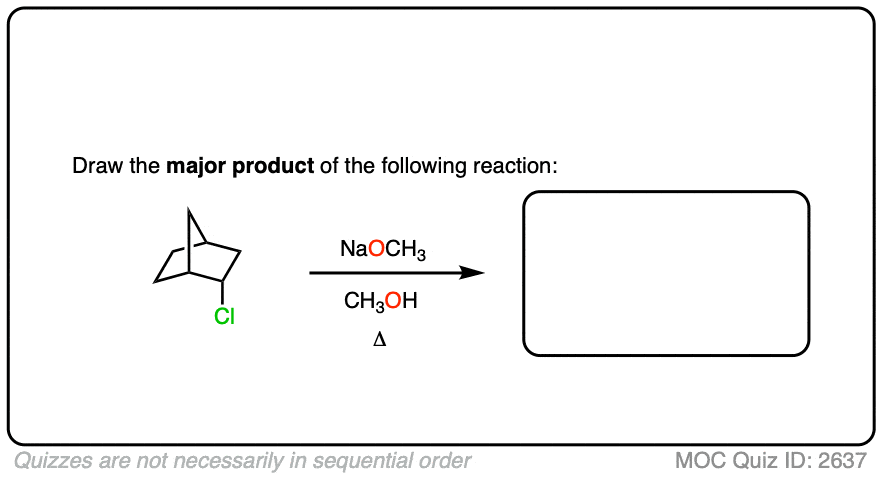 Click to Flip
Click to Flip
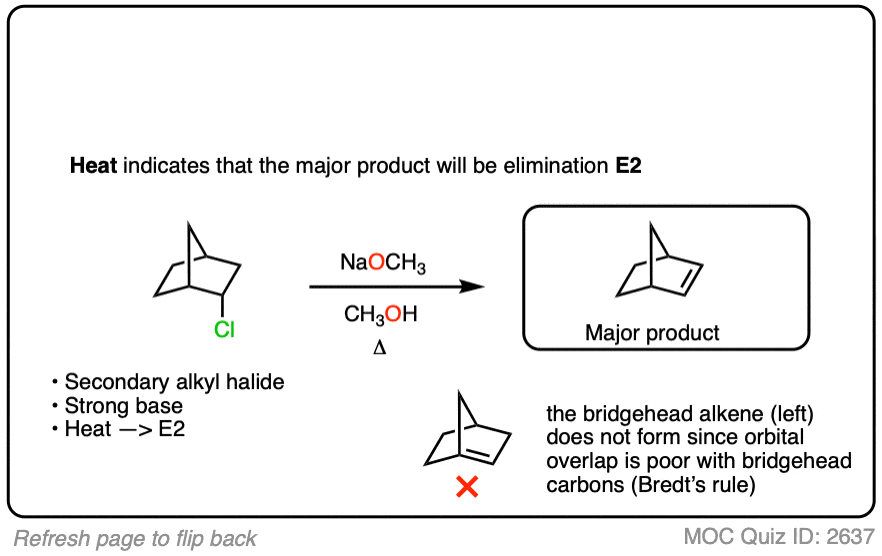
4. SN2 vs E2 – Primary Alkyl Halides
Another SN2 vs E2 dilemma is presented by a primary alkyl halide with a bulky strong base like KOt-Bu in the presence of heat.
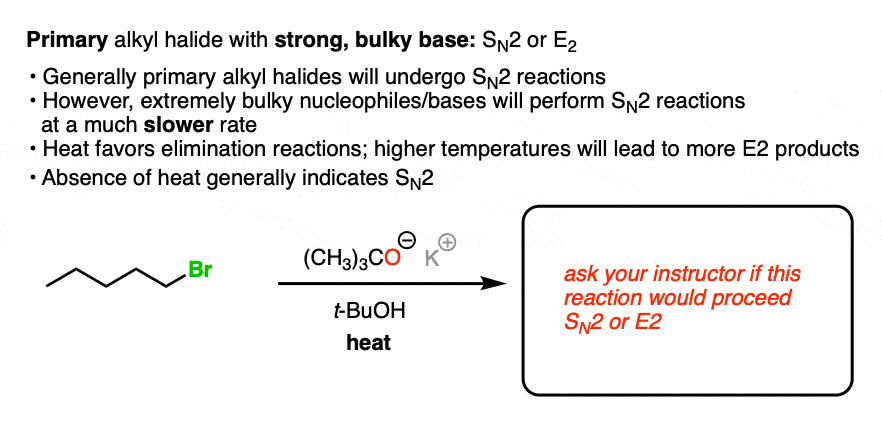
- It can’t be SN1/E1 (primary)
- It is likely SN2 but the bulky base and heat means that E2 is also a possibility
This is another situation where there is variation between different instructors. I’d suggest asking for clarity from your instructor on this specific question, because answers can vary.
Also be on the lookout for additional factors that may tip the scales away from SN2. For example, the presence of another alkyl group on the carbon adjacent to the primary alkyl halide will increase steric hindrance on the primary alkyl halide. Since the rate of the SN2 reaction is very sensitive to steric hindrance, this will make elimination more likely, relative to substitution.
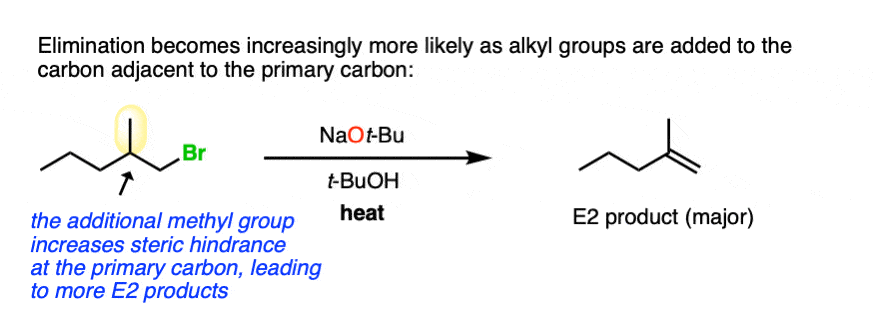
In the absence of heat, reactions of primary alkyl halides with t-butoxide ions will generally be SN2.
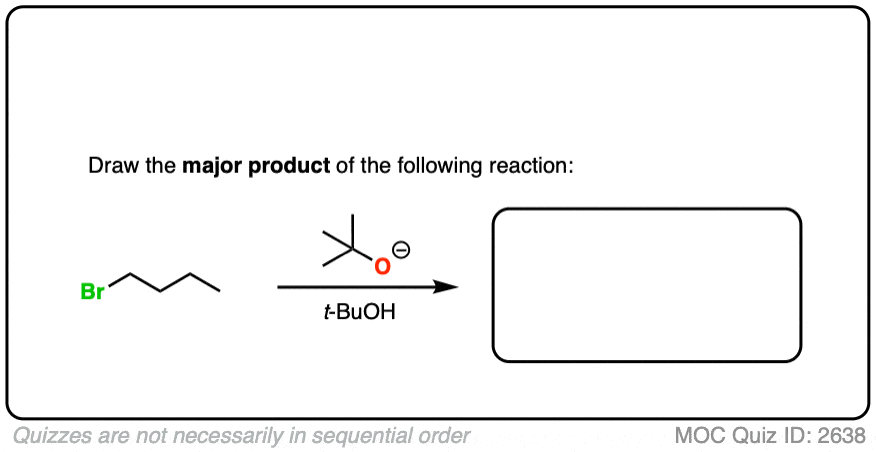 Click to Flip
Click to Flip
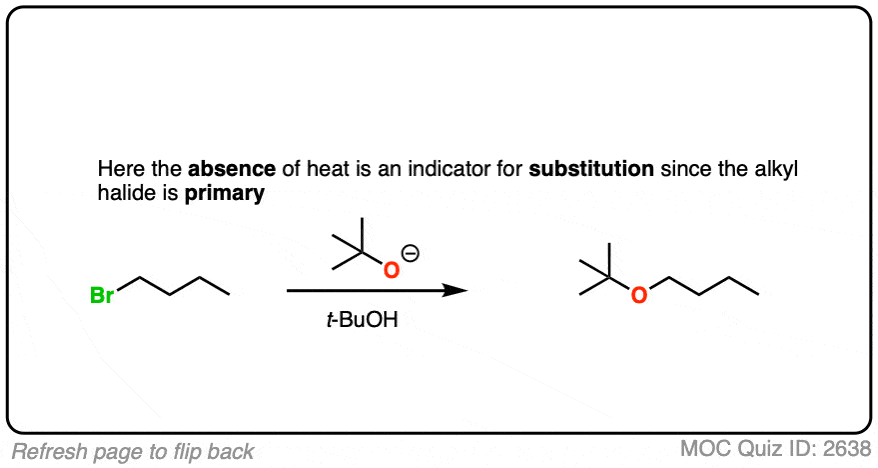
5. Heat and the SN1: Watch Out For Rearrangements
Although up to this point I’ve been suggesting a near-Pavlovian relationship between seing “heat” and thinking “elimination”, it’s worth putting up a final set of examples where heat is less likely to result in elimination.
Secondary alkyl halides can participate in substitution reactions via the SN1 pathway, but these reactions are generally quite slow. To happen at any kind of a practical rate, they generally require a kick in the pants in the form of added heat.
Secondary alkyl halides in the presence of poor nucleophiles (like H2O and alcohols) also provide an opportunity for your instructor to test you on rearrangement reactions such as hydride shifts and alkyl shifts. (See article: Rearrangement reactions with hydride shifts)
So in these cases (i.e. secondary alkyl halide with poor nucleophile/base) it’s advisable look at the added “heat” as making rearrangement more likely, rather than elimination.
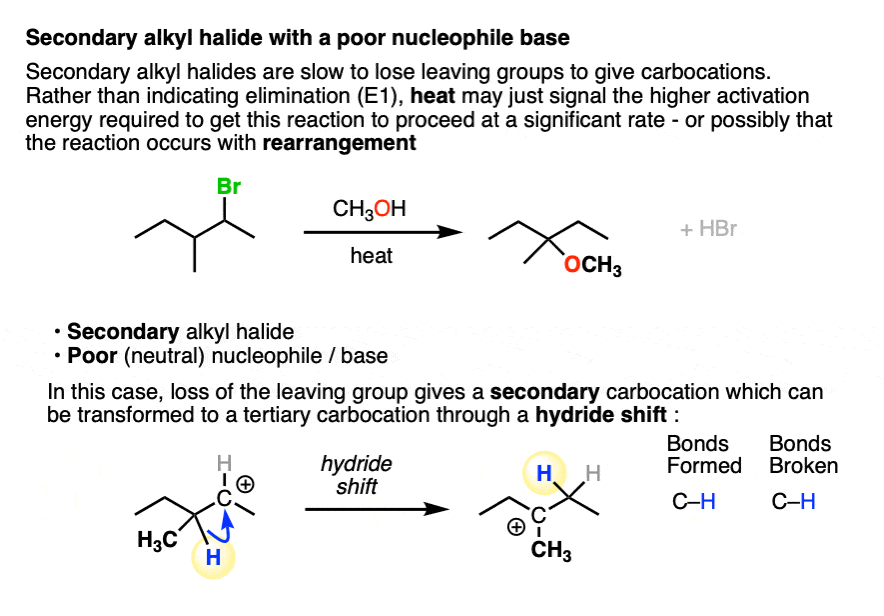
For some results from the lab regarding SN1 vs E1 on secondary alkyl halides, see Note 3.
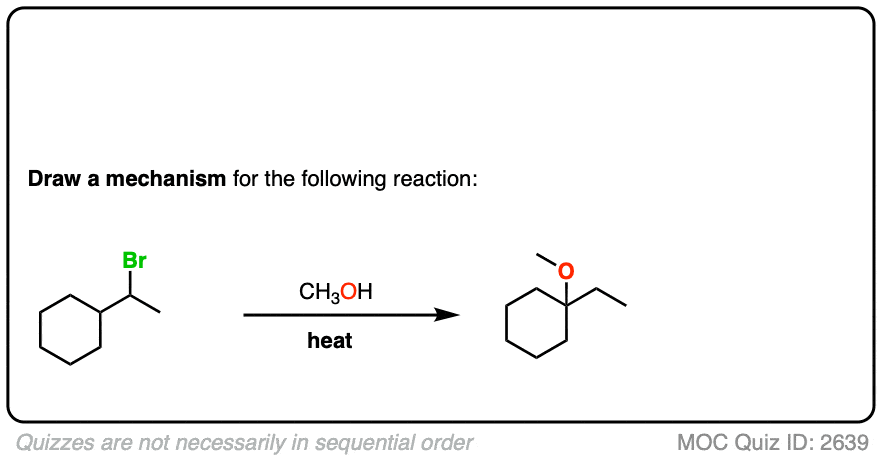 Click to Flip
Click to Flip
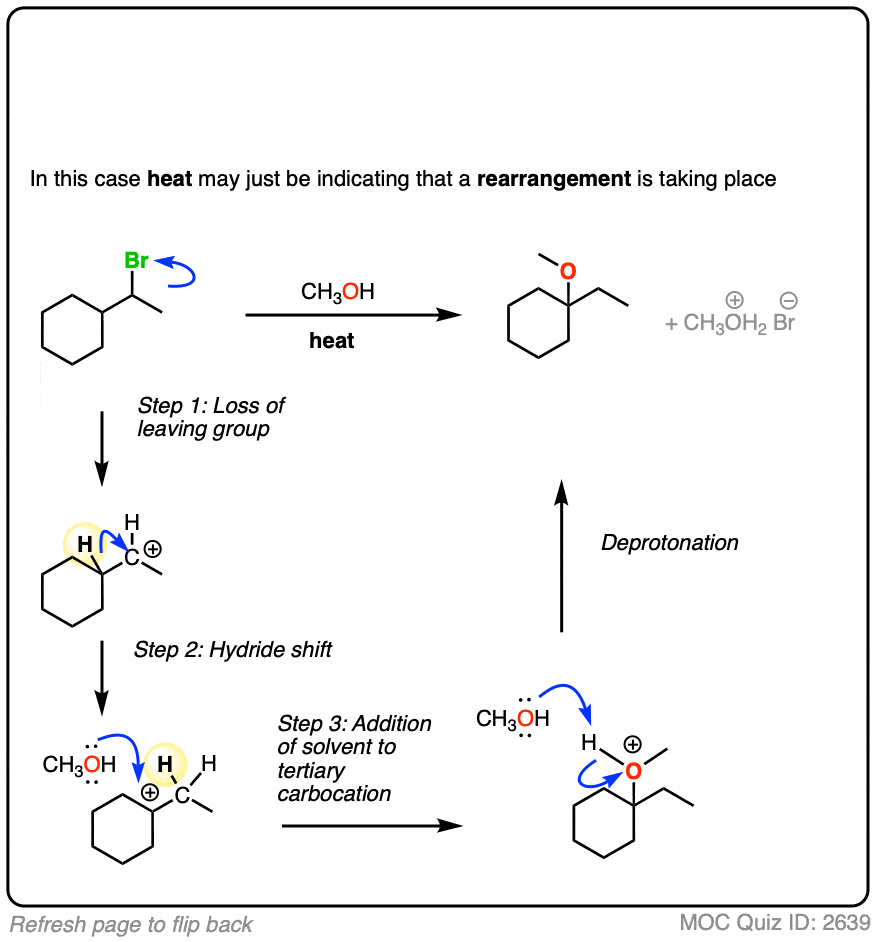
6. Summary
In case the point hasn’t been hammered home enough: if you see “heat”, think elimination.
At the very least, the clear trend is that as temperature is increased, the elimination: substitution ratio will increase.
For exam-preparation purposes, one possible exception to “heat = elimination” is the case of secondary alkyl halides in the presence of poor nucleophiles such as alcohols or H2O. In this case, heat provides the activation energy necessary for the leaving group to leave, forming a secondary carbocation (which may then undergo a subsequent elimination reaction, depending on structure).
In the next article, we’ll cover the last important variable in SN1/SN2/E1/E2 – the solvent. [See article: Deciding SN1/SN2/E1/E1 – The Solvent)
Notes
Note 1. The trend of increasing heat resulting in increased elimination products is clear. However it isn’t always as dramatic as it is in the first example.
Here are some examples from an early paper (J. Chem. Soc. 1948, p. 2049) that show a more modest relationship between temperature and heat.
First example is with t-butyl chloride with ethanol and water as solvent:
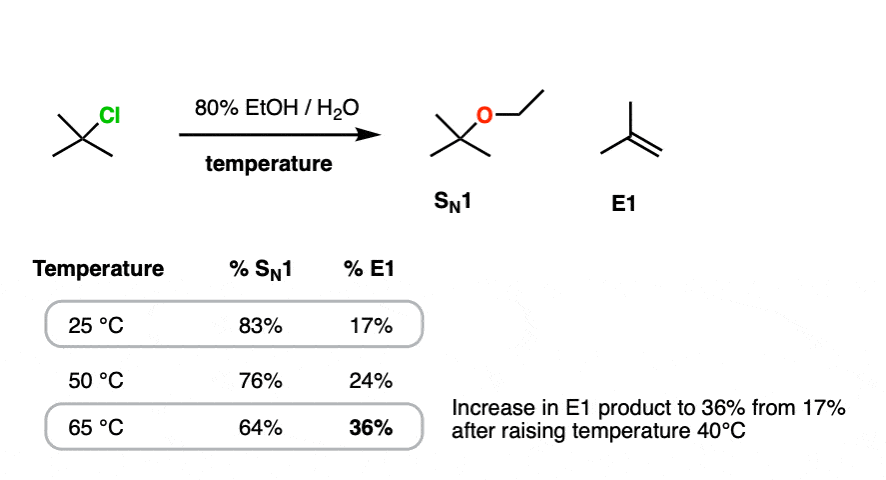
In the real world, adding heat is not like flipping a switch that suddenly changes the reaction from one major product to another. Going from 17% elimination at room temperature to 36% elimination at 65°C is a pretty modest change.
This is why SN1/E1 reactions don’t tend to get used that much in modern organic chemistry – we get mixtures, and mixtures take time to separate. A better use of our time is employing reactions that will give one dominant product (the E2 would be better for making the alkene here, for instance).
In the same article the authors ran a similar reaction with t-butyl bromide in 100% ethanol as solvent and varied the heat. The ratio of SN1: E1 went from 81:19 at 25°C to 72:28 at 55°C. Hover here to see this example or click this link.
Another reaction reported in the same paper was 2-chloro-2-methylbutane in 80% ethanol/water. At 25°C the SN1:E1 ratio was 67:33, which changed to 60:40 at 50°C. Hover here to see this example or click this link.
Note 2. Despite how important it might seem from the perspective of someone learning organic chemistry for the first time, there actually aren’t a huge number of examples of SN2 reactions actually working well between strong bases and secondary alkyl halides.
Maybe the best example is between isopropyl bromide (a.k.a. 2-bromopropane) and sodium ethoxide. In this case, the SN2 product is produced in 42% yield. This might seem OK at first, until we note that the major product is E2. With heating, the SN2:E2 ratio decreases even more.
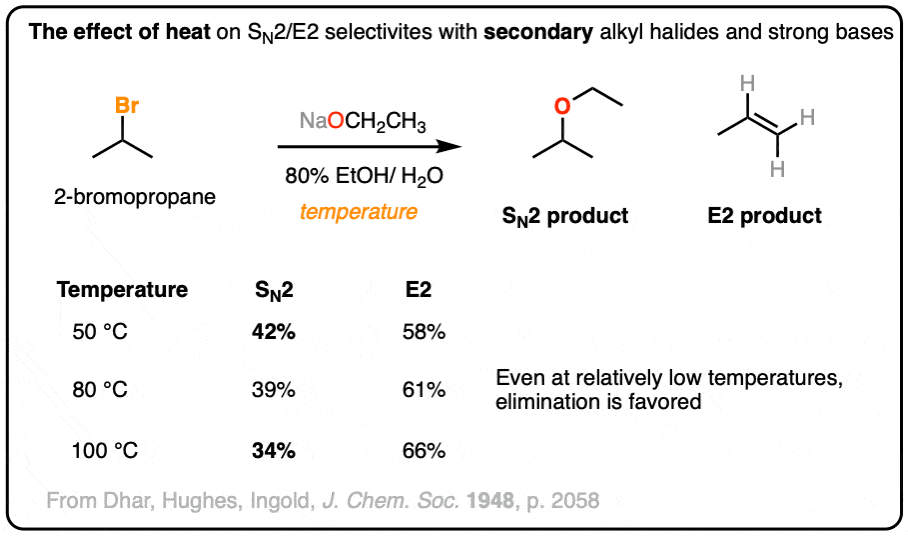
Things get even worse for SN2 once an extra alkyl group is added adjacent to the secondary carbon. For isobutyl bromide reacting with NaOEt in ethanol, the SN2:E2 ratio is 18:82 at 25°C and 9:91 at 80°C.
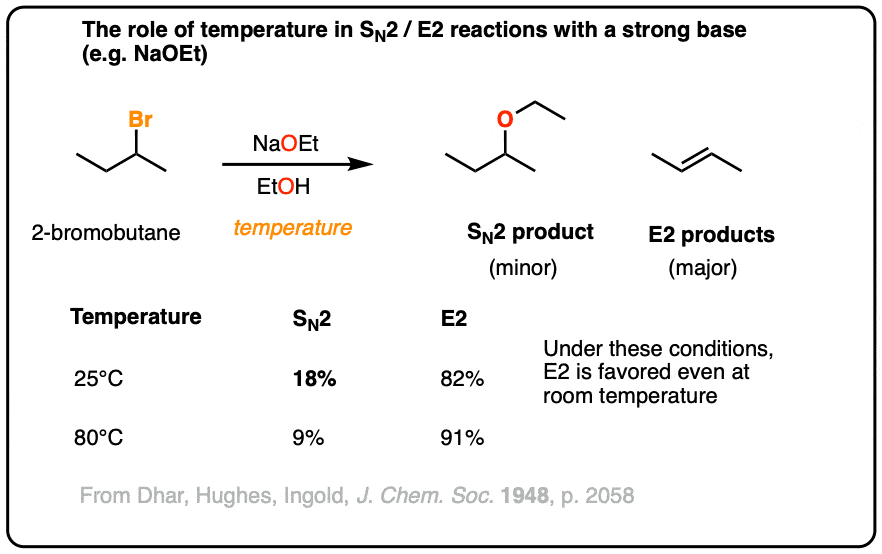
We’ll have more to say about the SN2 reaction of secondary alkyl halides with strongly basic nucleophiles in the next article, when we consider solvent.
Note 3. What about secondary alkyl halides with a poor nucleophile/base? What happens whcn this reaction mixture is heated? Does E1 dominate?
No. One study [Ref] heated a series of secondary alkyl halides in ethanol at 80°C. The resulting products were mostly substitution, with a small amount of elimination (5-15% depending on structure – the more hindered the secondary alkyl halide, the more elimination took place).
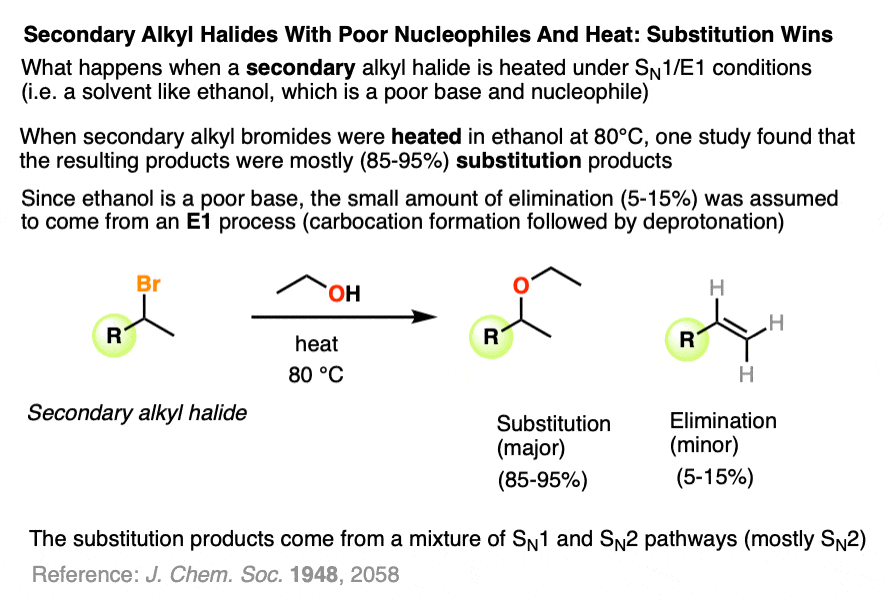
Since ethanol is a weak base and not really capable of deprotonation through E2, it was proposed that elimination mostly occurred through an E1 pathway (i.e. carbocation formation, followed by deprotonation to give the alkene).
The substitution products can arise through both SN2 (direct attack by the solvent) or SN1 (loss of the leaving group followed by attack of solvent).
At least in the simple cases studied, the major pathway is SN2.
(Another unpublished study subjected optically active 2-octyl tosylate to heating in ethanol and found the resulting ether (2-ethoxyoctane) to have 81% inversion of configuration. So SN2 really does seem to be dominant, at least in fairly simple cases.)
Quiz Yourself!
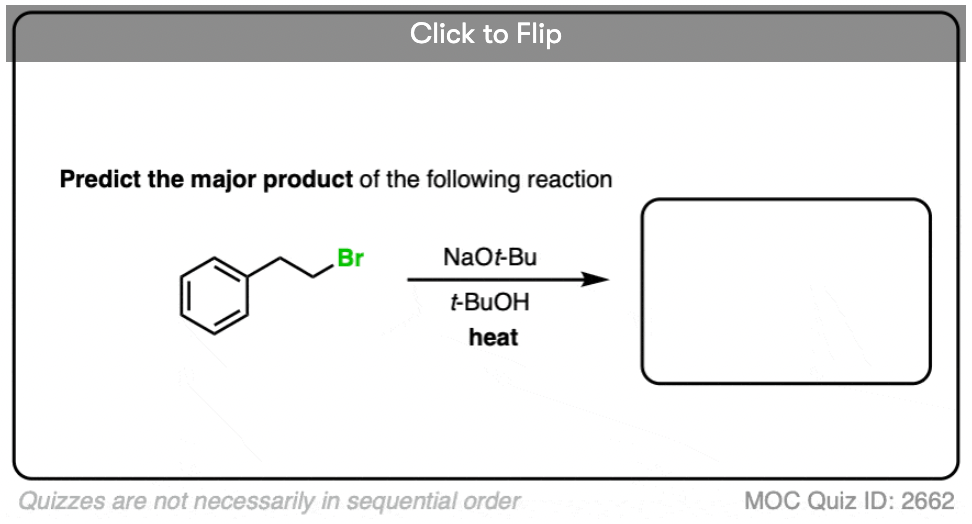
Become a MOC member to see the clickable quiz with answers on the back.
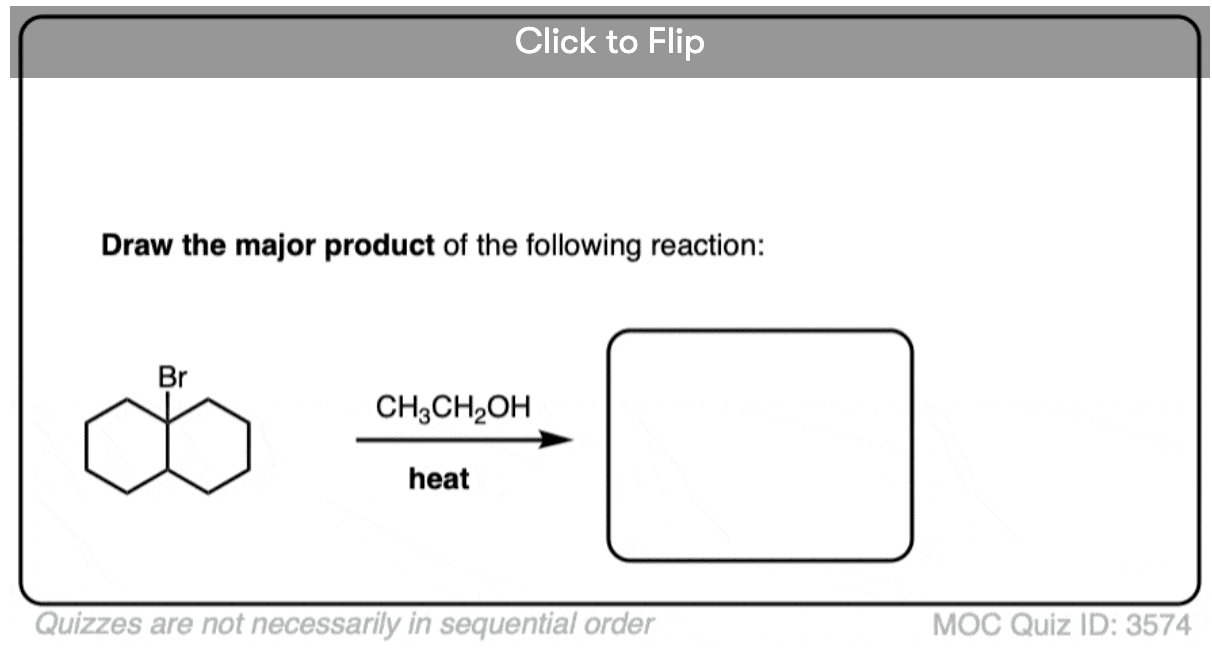
Become a MOC member to see the clickable quiz with answers on the back.
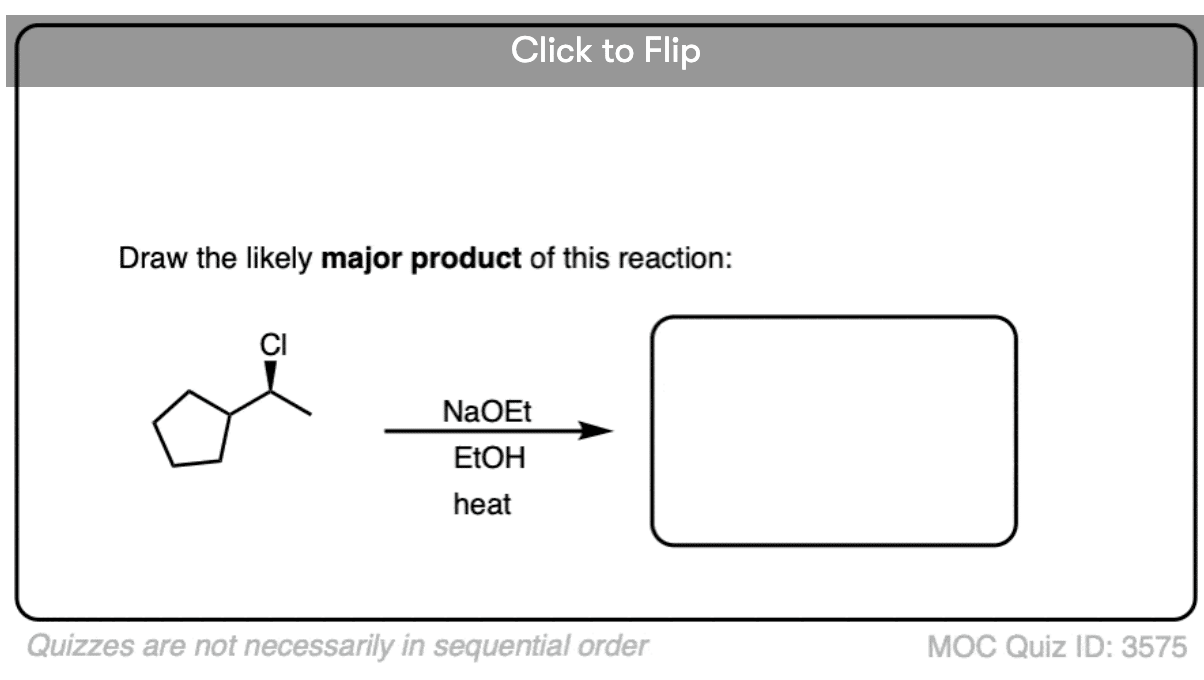
Become a MOC member to see the clickable quiz with answers on the back.
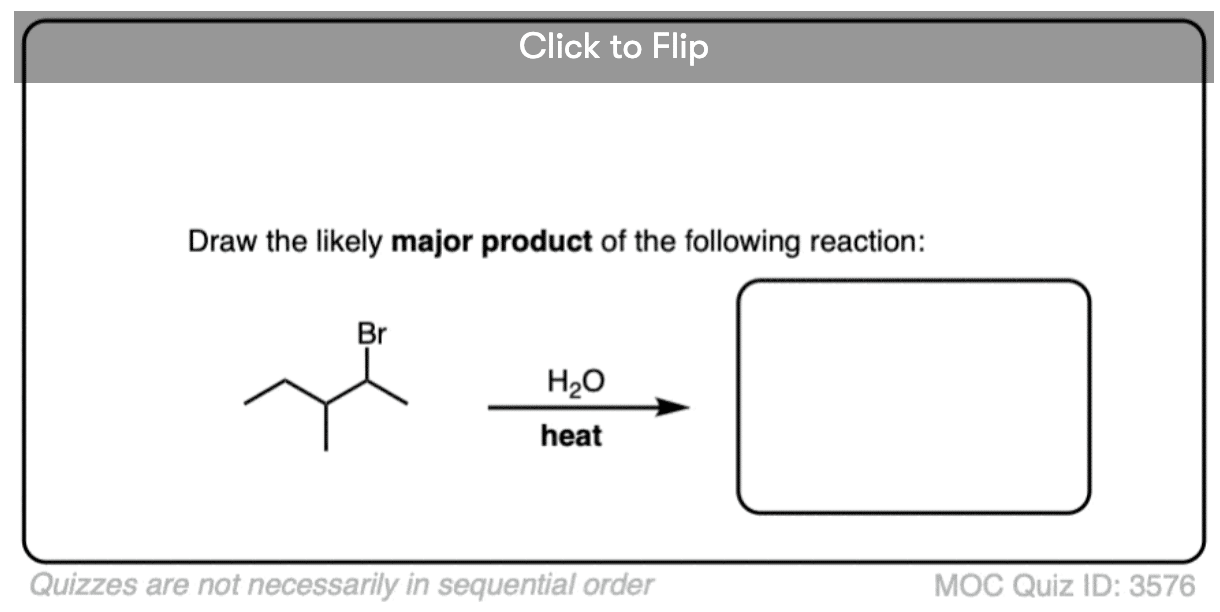
Become a MOC member to see the clickable quiz with answers on the back.
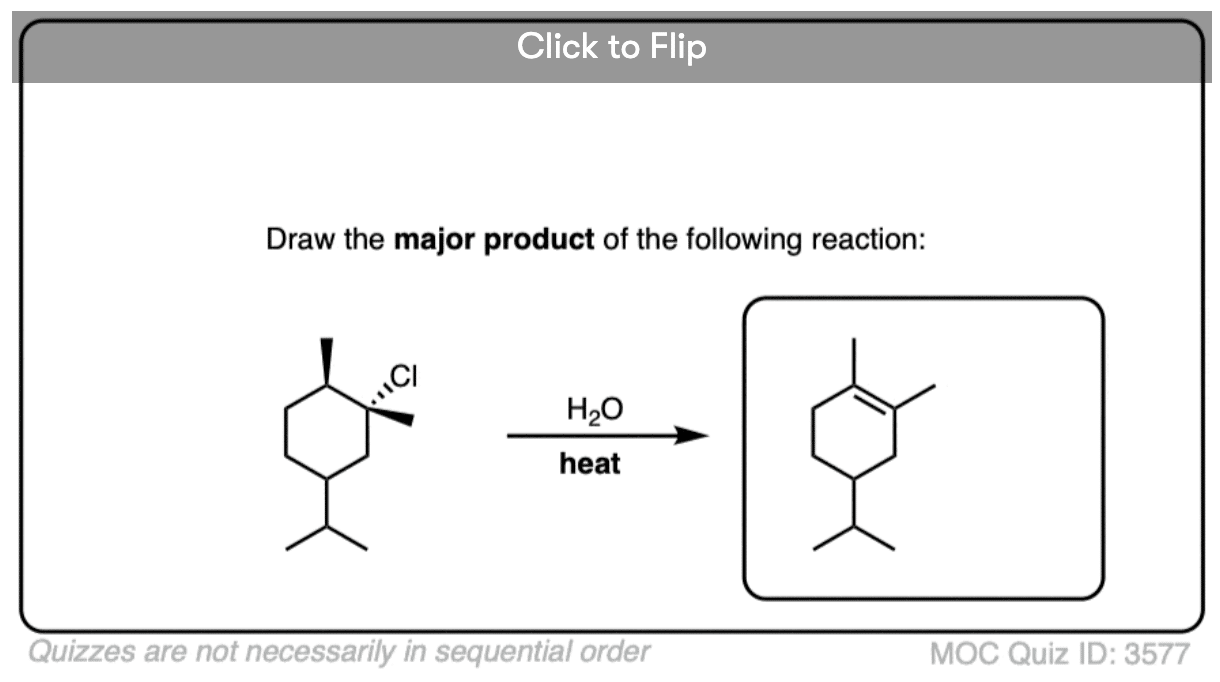
Become a MOC member to see the clickable quiz with answers on the back.
(Advanced) References and Further Reading
A general, but quite technical, overview of the SN1/SN2/E1/E2 landscape is given in Solvolytic Displacement Reactions by Andrew Streitweiser. It is a useful review of the fragmented early literature on SN1/SN2/E1/E2 that includes many tables still found in organic chemistry textbooks today.
Prof. Streitweiser also wrote a popular textbook for introductory organic chemistry in 1976, “Introduction To Organic Chemistry“, that went through multiple editions. The section on substitution reactions contains tables of relative rates and yields of various reactions that are also found in his earlier review.
I’m not sure if it’s completely fair to lay the current emphasis on SN1/SN2/E1/E2 reactions in introductory texts at the feet of Prof. Streitweiser, but there is no question his textbook has had a strong influence on it.
- 421. Mechanism of elimination reactions. Part XI. Kinetics of olefin elimination from tert.-butyl and tert.-amyl bromides in acidic and alkalinc alcoholic media
M. L. Dhar, E. D. Hughes, C. K. Ingold
J. Chem. Soc., 1948, 2065
DOI: 10.1039/JR9480002065
Among other things, this is a study of SN1 vs E1 at room temperature (25°C). At 25°C in ethanol, t-butyl bromide gives 81% substitution (SN1) and 19% elimination (E1) cor. t-amyl bromide (2-bromo-2-methylbutane) gives 64% SN1 and 36% E1. The rate constants for each of these reactions are also measured (Table VI). - 418. Mechanism of elimination reactions. Part VIII. Temperature effects on rates and product-proportions in uni- and bi-molecular substitution and elimination reactions of alkyl halides and sulphonium salts in hydroxylic solvents
K. A. Cooper, E. D. Hughes, C. K. Ingold, B. J. MacNulty
J. Chem. Soc., 1948, 2049-2054
DOI: 10.1039/JR9480002049
Study of the effect of increasing temperature on SN1 vs. E1 and SN2 vs. E2. In each case it is found that heat increases the proportion of elimination products. For SN2 and E2 they have this to say:
“For any given pair of simultaneous bimolecular processes, the elimination has, in each of the investigated cases, an Arrhenius energy of activation which lies higher than that of the accompanying substitution by 1-2 kcals/mol. The elimination thus has always the larger temperature coefficient, so that a rise of temperature increases the proportions in which olefin is formed.” For SN2 vs. E2 they measure the pre-exponential constant for the Arrhenius equation as well as the energies of activation. The pre-exponential constants for the elimination reactions are higher in each case.
For SN1 vs E1, the rate determining step is identical for both (loss of the leaving group). - 420. Mechanism of elimination reactions. Part X. Kinetics of olefin elimination from isopropyl, sec.-butyl, 2-n-amyl, and 3-n-amyl bromides in acidic and alkaline alcoholic media
M. L. Dhar, E. D. Hughes, C. K. Ingold
J. Chem. Soc. 1948. 2058-2065
DOI: 10.1039/JR9480002058
Intereresting result from this study is the relationship between heat and substitution/elimination products. Table I in this paper shows that solvolysis of 2-bromobutane with 1 M NaOEt in ethanol gives 82% yield of alkene at 25 °C, but similar solvolysis at 80 °C gives 91.4% yield of alkene. - Steric Effects in Elimination Reactions. IX. The Effect of the Steric Requirements of the Leaving Group on the Direction of Bimolecular Elimination in 2-Pentyl Derivatives
Herbert C. Brown and Owen H. Wheeler
Journal of the American Chemical Society 1956, 78 (10), 2199-2202
DOI: 1021/ja01591a049
Classic study on the proportion of alkenes formed through elimination of 2-bromopentane (and similar substrates) with t-butoxide bases. The major product is always the least substituted alkene (non-Zaitsev alkene). - The Hydrolysis of Tertiary Aliphatic Halides – I
H. Milton Woodburn and F. C. Whitmore
J. Am. Chem. Soc. 1934, 56, 1394
DOI: 10.1021/ja01321a055
Hard to find clear literature examples where heat = E1 and no heat = SN1, but this set from 1934 on the reaction of t-amyl halides is fairly straightforward. Conducting the hydrolysis of t-amyl bromide in the cold gives about 2:1 alcohol : alkene, whereas performing the same reaction under reflux gives exclusively elimination. Would like to see this reproduced under more modern conditions and quantified more thoroughly. Note that slight variations in structure (e.g. swapping t-Bu for t-Am, swapping Cl for Br, changing solvents) also has a significant effect on yields/ratios.
Tengo una pregunta a qué temperatura se llevan acábo la E2
In note 3, when we treated secondary alkyl halide with weak base , how did SN2 dominate?
As the base/nucleophile is weak(neutral) so it should be SN1,right?
Dr James, please also tell that if we are given a chair conformation of cyclohexane, will we have to do the reaction with that particular conformation only , or can we do ring flipping?
Hey i have a question. If i treat 2-iodo-3,4-dimethylpentane with tertiary butyl alcohol under sufficiently high temperature, what will be the major product? I’m struggling to know whether it’ll be an E1 or E2 product. Could you help me out here please ??
Since this is a secondary alkyl iodide, and there is a tertiary carbon adjacent to the secondary alkyl halide, my guess is that the heat is just helping the secondary alkyl halide form a carbocation. I would suggest that after formation of the carbocation you will get a hydride shift, followed by attack of tBuOH on to the tertiary carbocation.
Hi James, impressive amount of work in this site. On this page, I think the last two diagrams in the Notes section are out of sequence. The word heat is NOT omitted where the narrative says it is and vice-versa. (Or maybe I misunderstand your point!)
You are correct. Fixed. Thank you so much Len!
I think the last two images should replace each other. Since the last reaction should have ‘heat’ written on the arrow .
Thanks for the Post.
This site is just marvellous I never think of it thank u sir
Which pathway do we follow if the reaction in the question takes place at ‘mild heat’; E1 or SN1?
I would assume that “mild heat” is there for a purpose, and it is pushing towards E1.
in the example you extracted from “March” what exactly does 80% aqueous ethanol means? i mean is it ethanol which is in excess or the water? also i don’t understand how OH gets substituted i mean there’s no acid in the medium and if after OH2 gets substituted then who abstracted the extra proton from it?
It means 80% ethanol, 20% water. E.g. 800 mL EtOH and 200 mL H2O.
why is Br considered a strong nucleophile in the second and neutral in the last example???
Thank you
In the second example the “nucleophile” is KOEt which is charged and therefore “strong” (according to our “Quick N’ Dirty” rules). In the fourth example the “nucleophile” is CH3OH which is neutral (and therefore “weak” according to these rules).
The species containing Cl (in the second example) and Br (in the fourth example) are called the “substrate”.
I wish to know what would be the range of those high and low temperatures.
It is vague. But “heat” would generally refer to heating a solution to its boiling point (“reflux”) and the boiling point of most typical solvents for our purposes is 60-100 °C .
its very helpful for me.
After reading it i’m able to decide either the reaction is proceding through sn1/E1 or sn2/E2.
That’s the goal. If it’s helping you, I’m glad.
Dear Dr James
You discussed primary secondary tertiary carbons. What about alilic and benzilic carbons. Will primary benzilic carbon behaves like primary carbon?
Allylic and benzylic carbons will be more prone to going through carbocation pathways (SN1/E1) than typical primary carbons. If a charged nucleophile is present, using the Quick N’ Dirty rules I would generally expect substitution via SN2, and if the nucleophile is neutral (or using the solvent as nucleophile) the SN1 and E1 pathways start to become feasible, particularly with heat.
Well, a good example of this temperature thing is the addition of H2SO4 to primary alcohol. At 413K, elimination takes place to form alkene, but at 443K, ether is formed by SN1. Thank you so much for these thumb rules. Very helpful!
Will sn1 proceed in the reaction of a tertiary halide with ethanol in 25 degrees celsius?
If your question is related to an exam question, the answer is likely “yes”. Applying Quick N’ Dirty rules, tertiary rules out SN2, ethanol (neutral) rules out E2, and room temperature rules out E1. That leaves SN1.
If your question is related to a real-life reaction, my advice would be to go to March’s Advanced Organic Chemistry and look up “solvolysis rates” to get an idea of how quick it will be.
What should be the temperature for breaking C-Br bond ?
That’s not possible to answer without more information.
Fantastic job! Really on the money
I think it should be “In the fourth example we have a tertiary halide” instead of “In the fourth example we have a tertiary alcohol”.
Thank you!
I just wanted to thank you for the awesome website, and method of explanation of concepts you have here. I was struggling with this chapter for days, and reading your instructions, and rules, I understood the concept in an hour! and actually am answering the questions correctly. THANK YOU.
Oh wow, that is great Shahin. Glad to hear it. Keep in mind these ARE Quick N’ Dirty rules and are just a good place to start.
If we have tertiary alkyl halide,water or alcohol and 22 degree celcius what will be reaction?is it E1 or E2?
Likely SN1 – tertiary alkyl halide (not SN2) and weak nucleophile (water or alcohol) [ no E2] in the absence of heat.
Applying Quick N’ Dirty Rules: Tertiary alkyl halide rules out SN2. Water / alcohol rules out E2. Room temperature rules out E1. Why not SN1 ?